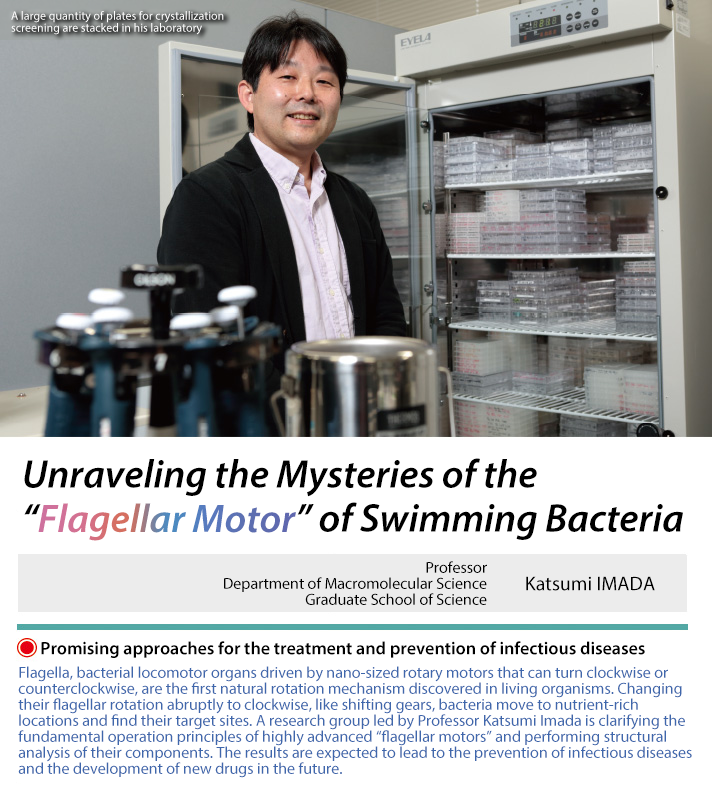
Unraveling the Mysteries of the "Flagellar Motor" of Swimming Bacteria
Molecular machinery to move a flagellum extending from a bacterial body
“Many pathogenic bacteria, such as Escherichia coli (E. coli) and Salmonella, swim by rotating a motor at the base of the flagellum, which extends from the body, at high speed, like a ship’s propeller,” said Professor Imada. A protein molecular motor about 45 nm in diameter rotates the flagellum. The motor rotates at 300 rps, comparable to the speed of an F1 engine, and can also turn counterclockwise. “The flagellar motor is the first rotation mechanism discovered in a living organism. It is also called a ‘molecular machine’ due to the mechanical nature of its movement.”
Professor Imada’s field of expertise is structural biology. Ever since he was profoundly intrigued by natural living organisms with mechanisms similar to man-made electric motors, he has devoted himself to the study of the structure and function of bacterial flagellar motors. “When confronted with a mysterious machine, it’s natural to want to study its shape and structure by taking it apart, and then put it back together and get it to work so that you can understand its mechanism. I am using this same approach to examine the mechanism of flagellar motors.”
A motor powered by ion flow
“Flagellar motors,” extremely high-performance nano machines, are driven by a bacterial flagellar motor which draws its energy from an ion flux entering the cell, just like man-made electric motors are driven by the flow of electrons. But how does a flagellar motor that has no rudder like those found on a ship control its direction to reach a place to adhere to? “Like a nose and tongue, bacteria have a sensory organelle to detect surrounding substances and transmit signals to the motor. Detecting them, they reverse the motor just like changing gears. And just like a ship’s propeller, when the flagella is rotating clockwise, the entire cell stops its forward movement and drift, then begins swimming again in some new random direction. The flagellum is driving the cell forward towards the attractant while repeatedly correcting its direction by spinning in an either clockwise or counterclockwise direction.”

Performing low-file research to become the “first witness”
The shape and structure of many components of the flagellar motor are still unknown at the molecular level, so Professor Imada is working to verify these unknown areas using X-ray crystallography*. “We conduct hundreds and thousands of screenings under various conditions with different reagent types and concentrations to create crystals, or molecular aggregates. We isolate crystals one by one while observing them using a microscope, freeze them by immersing them in liquid nitrogen, and send them to the large SPring-8 synchrotron radiation facility (located in Hyogo Prefecture) to collect and analyze the experimental data.” For all that, they often failed to obtain crystals. It’s a series of monotonous and repetitive work through trial and error. But, with a confident look in his eye, he said, “I was really moved when I became the ‘first witness’ of a structure that no one has ever seen in human history.”
*X-ray crystallography is a technique that uses X-ray diffraction patterns to determining three-dimensional structure of a crystal

Preventing the delivery through bacterial venomous needles will lead to the development of body-friendly medicines
The study of flagellar motors shows that the flagellar base functions as a “distribution center” for exporting and assembling proteins that are made in a cell and become a part of the flagellum. “Pathogenic bacteria have ‘venomous needles.’ For example, O-157 uses a needle to inject virulence proteins into intestinal epithelial cells and multiply there. The mechanism of the needle was found to be almost the same as the mechanism for exporting components of the flagellar motor. If the export of pathogenic protein from needles can be prevented, the pathogenic bacteria cannot cause infection even if they reach target cells.”
Administration of antibiotics kills both pathogenic bacteria and good bacteria in the intestines, causing the problem of drug-resistant strains as well. However, if export through needles can be prevented, “this will render pathogenic bacteria harmless.” Future results of this research are highly anticipated in that they will lead to the development of drugs that are gentle on the body with fewer side effects.
Scientists should be optimistic

Professor Imada enjoys sports such as skiing and baseball in between research. On the other hand, his commitment to the planetary explorer Voyager launched by NASA in his high-school days illustrates his inherent interest in science. “Science is fun! Investigating the unknown is very intriguing.”
Asked about the qualities needed to be a good researcher, he said, “Being optimistic. We have more hits than misses in research. So, even if you think you failed in experiment, it’s important to examine that with other possibilities in mind. In science, it’s risky to challenge your own assumption in a blindly with no established answers. I think the only way to reach right answers is to make examinations in the same staggering way that bacteria move by reversing their flagellar motor repeatedly.”
•Katsumi IMADA
A 1987 graduate of the School of Science, Osaka University, Prof. Imada received his doctorate of science from the Department of Macromolecular Science, Graduate School of Science, Osaka University in 1992. After serving as researcher at the International Institute for Advanced Research, Matsushita Electric Industrial Co., Ltd., Assistant Professor at the Graduate School of Frontier Biosciences, Osaka University, Group Leader of Dynamic Nanomachine Project, International Cooperative Research Project (ICORP), Japan Science and Technology Agency (JST), and Associate Professor at the Graduate School of Frontier Biosciences, Osaka University, he arrived at his current position of Professor at the Graduate School of Science, Osaka University in October 2010.